
Click the name of a planet to learn more about its visibility in January 2021: Jupiter, Saturn, Mars, Venus, Mercury
Try Stellarium for a precise view of the planets from your location.
Want precise planet rise and set times? Click here for recommended almanacs
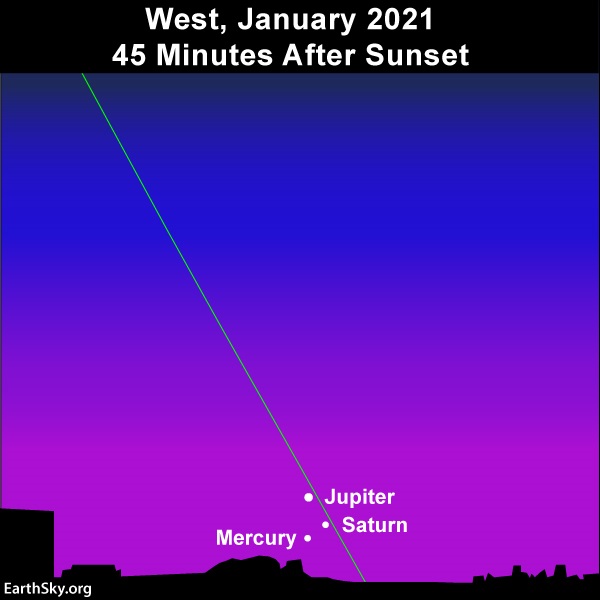
This chart is for January 9, 2021, when Mercury is in conjunction with Saturn. For several days, centered on January 10, a planetary trio – a tight gathering of 3 planets – adorns the evening dusk. Bring your binoculars! Read more.
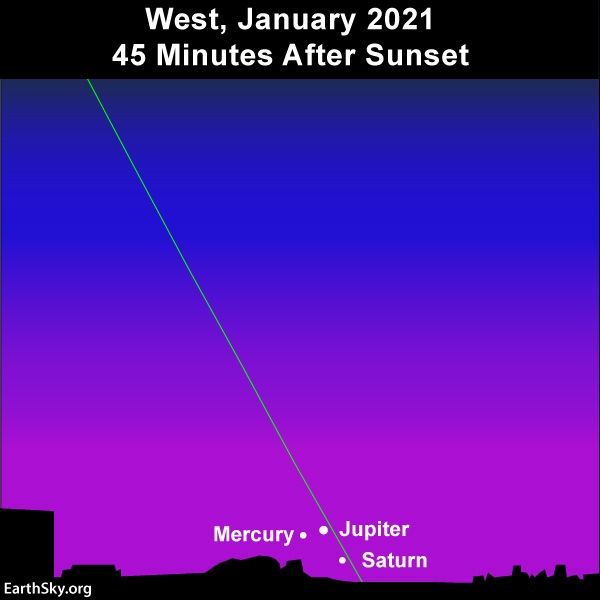
Contrast this chart – which is for January 11, 2021, at mid-northern North American latitudes – with the above chart for January 9. The fleet-footed planet Mercury, named for the messenger of the ancient gods, passes to the south of Saturn on January 9, and then to the south of Jupiter on January 11. Read more.
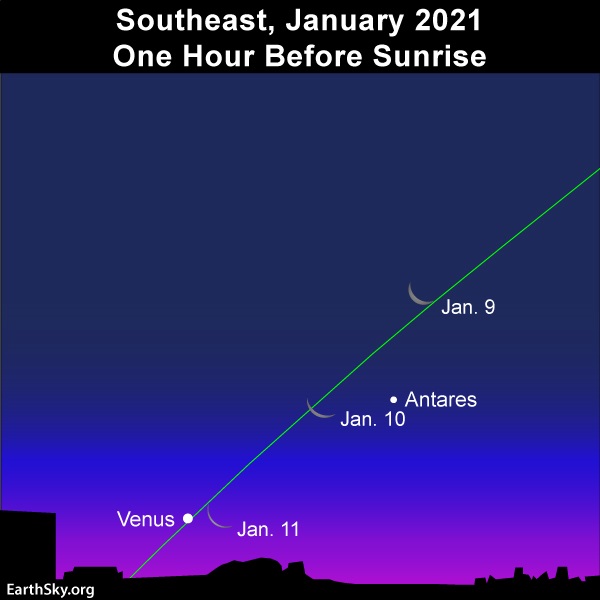
After catching the planetary trio in the west at dusk, get up early to enjoy the waning crescent moon and dazzling planet Venus in the east before sunrise. Read more.
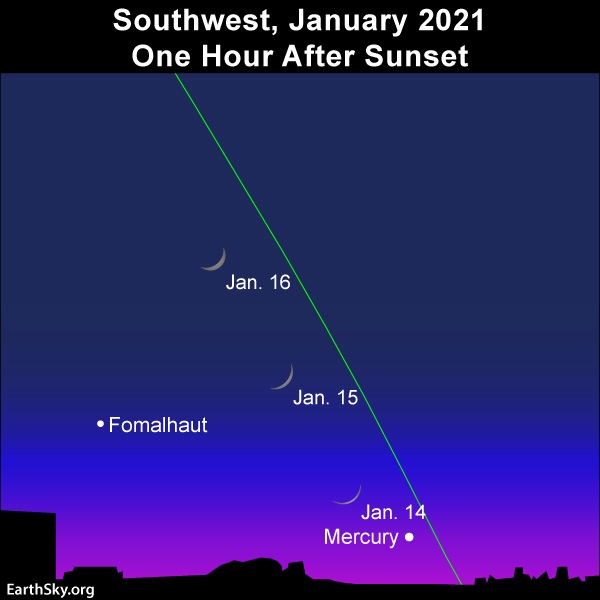
Let the young moon help you to locate Mercury after sunset on January 14, 15 and 16, 2021. Read more.

Mars is the only bright evening planet to be out after nightfall all through January 2021. Let the moon help guide your eye to Mars on January 19, 20 and 21. Read more.
Jupiter and Saturn come out at evening dusk in early January, yet lurk quite low in the sky. Moreover, they follow the sun beneath the horizon before nightfall. Day by day, the twosome appears a bit lower in the sky at dusk, and sets sooner after sundown. For the best view of these worlds, find an unobstructed horizon in the direction of sunset, and seek them out about 45 to 60 minutes after the sun goes down with either the eye alone or binoculars. Both of these worlds will disappear from the evening sky during the second half of January, as they transition out of the evening sky and into the morning sky.
Around the world, Jupiter and Saturn set about 1 1/2 hours after the sun in early January. That’ll taper to 1/2 hour or so by mid-month.
Have binoculars handy for this month’s planetary trio, or three planets congregating together on the sky’s dome! Day by day, as Jupiter and Saturn sink downward, toward the setting sun, Mercury will be climbing out of the afterglow of sunset. Mercury will meet up with Saturn for a conjunction on January 9, and then rendezvous with Jupiter for a slightly closer conjunction on January 11. These three planets will be out at evening dusk, but will set before nightfall, so you’ll need an unobstructed horizon to spot their furtive gathering in the evening twilight. Read more.
Look first for brilliant Jupiter; Saturn is the bright object immediately above Jupiter. Although Saturn is easily as bright as a 1st-magnitude star – as bright as the brightest stars in our sky – the ringed planet can’t compete with the the king planet Jupiter, which outshines Saturn by some 11 times. After all, Jupiter ranks as the fourth brightest celestial object, after the sun, the moon and the planet Venus, respectively. (But there’s no way to mistake Jupiter for Venus, or vice versa, because Jupiter is out at evening dusk, whereas Venus is out at morning dawn.)
Mars is the only bright planet that’s out at nightfall and the evening hours throughout January 2021. The three other evening planets – Mercury, Jupiter and Saturn – only appear at evening dusk (if at all) and exit the sky by nightfall. Mars is highest up for the night at nightfall and slowly descends westward during the evening hours, finally setting in the west at or around midnight. Its ruddy starlike presence still lights up our evening sky, although in the months ahead, Mars will slowly but surely dim.
Modesty-bright Mars remains an easy object to see with the eye alone throughout January. Let the moon help guide your eye to Mars for several nights centered on or near January 20.
Venus – the brightest planet – reached its greatest elongation from the sun in the morning sky on August 12 or 13 (depending upon your time zone). In January 2021, however, Venus’ elongation is not so profound, and what’s more, Venus’ angular distance from the sun shrinks throughout the month. Day by day, watch for Venus to sink deeper and deeper into the morning twilight.
At mid-northern latitudes, Venus rises about 1 1/2 hours before the sun in early January, tapering down to about 35 minutes by the month’s end.
At and near the equator, Venus rises 1 1/2 hours before the sun in early January, decreasing to 55 minutes by the month’s end.
At temperate latitudes in the Southern Hemisphere, Venus rises 1 1/2 hours before the sun in early January, and around 1 hour by the month’s end.
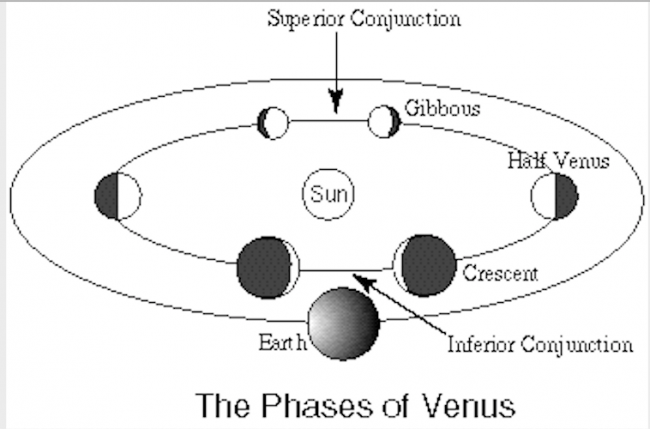
Inferior conjunction – when Venus sweeps between the sun and Earth – happened on June 3, 2020. Some 10 weeks later, Venus reached its greatest elongation in the morning sky on August 13, 2020 (when its disk was about 50% illuminated by sunshine). In January 2021, Venus will start the month about 94% illuminated and then end the month about 97% illuminated. Image via UCLA.
Throughout January, Venus in its faster orbit around the sun will be going farther and farther away from Earth. As viewed through the telescope, Venus’ waxing gibbous phase will widen, yet its overall disk size will shrink. Venus’ disk is 94% illuminated in early January, and 97% illuminated near the month’s end; Venus’ angular diameter, on the other hand, will shrink to about 94% of its initial size by the end of January.
Watch for the waning crescent moon to shine with Venus in the morning sky for several days, centered around January 11.
Mercury is nominally an evening object all month long in January. However, this world sits quite close to the afterglow of sunset in early January, and probably won’t be visible in the evening twilight until after the first week of January.
Day by day, as Mercury climbs away from the setting sun, the planets Jupiter and Saturn sink sunward. All three planets – Mercury, Jupiter and Saturn – will appear in nearly the same spot on the great dome of sky for several days, centered on January 10. Dazzling Jupiter – the 4th-brightest celestial object in all the heavens – is your ticket to finding Mercury and Saturn. Bring along your binoculars, find an unobstructed western horizon and start your search no later than 45 minute after sunset. Read more.
Mercury will have a conjunction with Saturn on January 9, and then a conjunction with Jupiter on January 11. In between these two dates – on January 10 – these three planets will snuggle up most closely on the sky’s dome for the month, fitting inside a circle measuring 2.4 degrees in diameter. (For reference, the width of a finger at an arm length spans about 2 degrees of sky.) A grouping of three planets in a circle whose diameter spans 5 degrees or less is known as a planetary trio.
The most recent planetary trio last took place on October 26, 2015. Next month, we’ll have one in the morning sky on February 13, 2021. After that, the next planetary trio won’t occur until April 20, 2026.
Starting around mid-month, as Jupiter and Saturn fade into sun’s glare, Mercury should become more easily visible to the eye alone in the evening sky. Use the moon to help you locate Mercury on January 14, 15 and 16.
Best yet, perhaps, watch for Mercury around the time of its greatest elongation from the setting sun on January 23. At mid-northern latitudes, Mercury stays out a whopping 90 minutes after sunset, providing you with a great opportunity to spot the solar system’s innermost planet!

As viewed from mid-northern latitudes, Mercury and the star Fomalhaut shine nearly side by side at evening dusk as Mercury reaches its greatest elongation on January 23, 2021. Read more.
What do we mean by bright planet? By bright planet, we mean any solar system planet that is easily visible without an optical aid and that has been watched by our ancestors since time immemorial. In their outward order from the sun, the five bright planets are Mercury, Venus, Mars, Jupiter and Saturn. These planets actually do appear bright in our sky. They are typically as bright as – or brighter than – the brightest stars. Plus, these relatively nearby worlds tend to shine with a steadier light than the distant, twinkling stars. You can spot them, and come to know them as faithful friends, if you try.
Bottom line: January starts out the month with two bright planets at dusk, Jupiter and Saturn, which then team up with Mercury to showcase a spectacularly-close threesome at dusk January 10. Mars is the only bright planet to light up the evening hours after nightfall. Dazzling Venus, the sole bright morning planet, rises in the east at dawn.
Don’t miss anything. Subscribe to EarthSky News by email
Visit EarthSky’s Best Places to Stargaze to find a dark-sky location near you.
Help EarthSky keep going! Donate now.
Post your planet photos at EarthSky Community Photos.
from EarthSky https://ift.tt/1YD00CF

Click the name of a planet to learn more about its visibility in January 2021: Jupiter, Saturn, Mars, Venus, Mercury
Try Stellarium for a precise view of the planets from your location.
Want precise planet rise and set times? Click here for recommended almanacs

This chart is for January 9, 2021, when Mercury is in conjunction with Saturn. For several days, centered on January 10, a planetary trio – a tight gathering of 3 planets – adorns the evening dusk. Bring your binoculars! Read more.

Contrast this chart – which is for January 11, 2021, at mid-northern North American latitudes – with the above chart for January 9. The fleet-footed planet Mercury, named for the messenger of the ancient gods, passes to the south of Saturn on January 9, and then to the south of Jupiter on January 11. Read more.

After catching the planetary trio in the west at dusk, get up early to enjoy the waning crescent moon and dazzling planet Venus in the east before sunrise. Read more.

Let the young moon help you to locate Mercury after sunset on January 14, 15 and 16, 2021. Read more.

Mars is the only bright evening planet to be out after nightfall all through January 2021. Let the moon help guide your eye to Mars on January 19, 20 and 21. Read more.
Jupiter and Saturn come out at evening dusk in early January, yet lurk quite low in the sky. Moreover, they follow the sun beneath the horizon before nightfall. Day by day, the twosome appears a bit lower in the sky at dusk, and sets sooner after sundown. For the best view of these worlds, find an unobstructed horizon in the direction of sunset, and seek them out about 45 to 60 minutes after the sun goes down with either the eye alone or binoculars. Both of these worlds will disappear from the evening sky during the second half of January, as they transition out of the evening sky and into the morning sky.
Around the world, Jupiter and Saturn set about 1 1/2 hours after the sun in early January. That’ll taper to 1/2 hour or so by mid-month.
Have binoculars handy for this month’s planetary trio, or three planets congregating together on the sky’s dome! Day by day, as Jupiter and Saturn sink downward, toward the setting sun, Mercury will be climbing out of the afterglow of sunset. Mercury will meet up with Saturn for a conjunction on January 9, and then rendezvous with Jupiter for a slightly closer conjunction on January 11. These three planets will be out at evening dusk, but will set before nightfall, so you’ll need an unobstructed horizon to spot their furtive gathering in the evening twilight. Read more.
Look first for brilliant Jupiter; Saturn is the bright object immediately above Jupiter. Although Saturn is easily as bright as a 1st-magnitude star – as bright as the brightest stars in our sky – the ringed planet can’t compete with the the king planet Jupiter, which outshines Saturn by some 11 times. After all, Jupiter ranks as the fourth brightest celestial object, after the sun, the moon and the planet Venus, respectively. (But there’s no way to mistake Jupiter for Venus, or vice versa, because Jupiter is out at evening dusk, whereas Venus is out at morning dawn.)
Mars is the only bright planet that’s out at nightfall and the evening hours throughout January 2021. The three other evening planets – Mercury, Jupiter and Saturn – only appear at evening dusk (if at all) and exit the sky by nightfall. Mars is highest up for the night at nightfall and slowly descends westward during the evening hours, finally setting in the west at or around midnight. Its ruddy starlike presence still lights up our evening sky, although in the months ahead, Mars will slowly but surely dim.
Modesty-bright Mars remains an easy object to see with the eye alone throughout January. Let the moon help guide your eye to Mars for several nights centered on or near January 20.
Venus – the brightest planet – reached its greatest elongation from the sun in the morning sky on August 12 or 13 (depending upon your time zone). In January 2021, however, Venus’ elongation is not so profound, and what’s more, Venus’ angular distance from the sun shrinks throughout the month. Day by day, watch for Venus to sink deeper and deeper into the morning twilight.
At mid-northern latitudes, Venus rises about 1 1/2 hours before the sun in early January, tapering down to about 35 minutes by the month’s end.
At and near the equator, Venus rises 1 1/2 hours before the sun in early January, decreasing to 55 minutes by the month’s end.
At temperate latitudes in the Southern Hemisphere, Venus rises 1 1/2 hours before the sun in early January, and around 1 hour by the month’s end.

Inferior conjunction – when Venus sweeps between the sun and Earth – happened on June 3, 2020. Some 10 weeks later, Venus reached its greatest elongation in the morning sky on August 13, 2020 (when its disk was about 50% illuminated by sunshine). In January 2021, Venus will start the month about 94% illuminated and then end the month about 97% illuminated. Image via UCLA.
Throughout January, Venus in its faster orbit around the sun will be going farther and farther away from Earth. As viewed through the telescope, Venus’ waxing gibbous phase will widen, yet its overall disk size will shrink. Venus’ disk is 94% illuminated in early January, and 97% illuminated near the month’s end; Venus’ angular diameter, on the other hand, will shrink to about 94% of its initial size by the end of January.
Watch for the waning crescent moon to shine with Venus in the morning sky for several days, centered around January 11.
Mercury is nominally an evening object all month long in January. However, this world sits quite close to the afterglow of sunset in early January, and probably won’t be visible in the evening twilight until after the first week of January.
Day by day, as Mercury climbs away from the setting sun, the planets Jupiter and Saturn sink sunward. All three planets – Mercury, Jupiter and Saturn – will appear in nearly the same spot on the great dome of sky for several days, centered on January 10. Dazzling Jupiter – the 4th-brightest celestial object in all the heavens – is your ticket to finding Mercury and Saturn. Bring along your binoculars, find an unobstructed western horizon and start your search no later than 45 minute after sunset. Read more.
Mercury will have a conjunction with Saturn on January 9, and then a conjunction with Jupiter on January 11. In between these two dates – on January 10 – these three planets will snuggle up most closely on the sky’s dome for the month, fitting inside a circle measuring 2.4 degrees in diameter. (For reference, the width of a finger at an arm length spans about 2 degrees of sky.) A grouping of three planets in a circle whose diameter spans 5 degrees or less is known as a planetary trio.
The most recent planetary trio last took place on October 26, 2015. Next month, we’ll have one in the morning sky on February 13, 2021. After that, the next planetary trio won’t occur until April 20, 2026.
Starting around mid-month, as Jupiter and Saturn fade into sun’s glare, Mercury should become more easily visible to the eye alone in the evening sky. Use the moon to help you locate Mercury on January 14, 15 and 16.
Best yet, perhaps, watch for Mercury around the time of its greatest elongation from the setting sun on January 23. At mid-northern latitudes, Mercury stays out a whopping 90 minutes after sunset, providing you with a great opportunity to spot the solar system’s innermost planet!

As viewed from mid-northern latitudes, Mercury and the star Fomalhaut shine nearly side by side at evening dusk as Mercury reaches its greatest elongation on January 23, 2021. Read more.
What do we mean by bright planet? By bright planet, we mean any solar system planet that is easily visible without an optical aid and that has been watched by our ancestors since time immemorial. In their outward order from the sun, the five bright planets are Mercury, Venus, Mars, Jupiter and Saturn. These planets actually do appear bright in our sky. They are typically as bright as – or brighter than – the brightest stars. Plus, these relatively nearby worlds tend to shine with a steadier light than the distant, twinkling stars. You can spot them, and come to know them as faithful friends, if you try.
Bottom line: January starts out the month with two bright planets at dusk, Jupiter and Saturn, which then team up with Mercury to showcase a spectacularly-close threesome at dusk January 10. Mars is the only bright planet to light up the evening hours after nightfall. Dazzling Venus, the sole bright morning planet, rises in the east at dawn.
Don’t miss anything. Subscribe to EarthSky News by email
Visit EarthSky’s Best Places to Stargaze to find a dark-sky location near you.
Help EarthSky keep going! Donate now.
Post your planet photos at EarthSky Community Photos.
from EarthSky https://ift.tt/1YD00CF


Aucun commentaire:
Enregistrer un commentaire